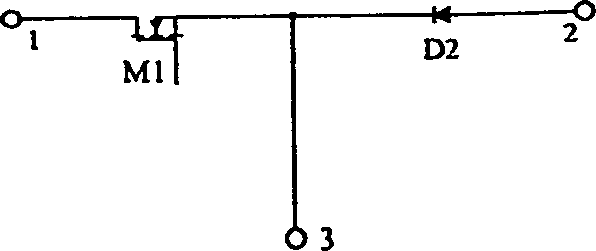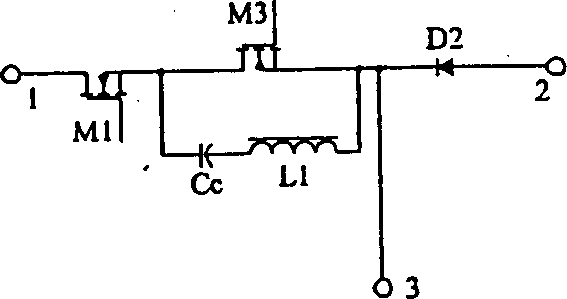Minimum voltage type active clamp DC-DC converter
A DC converter and voltage-type technology, applied in the direction of converting DC power input to DC power output, adjusting electrical variables, instruments, etc., can solve problems such as high related losses, large voltage stress, and increased voltage stress of the main switch and auxiliary switch
- Summary
- Abstract
- Description
- Claims
- Application Information
AI Technical Summary
Problems solved by technology
Method used
Image
Examples
Embodiment Construction
[0025] image 3 The basic conversion circuit shown includes main switching tube M1, diode D2, auxiliary switching tube M3, clamping capacitor Cc and auxiliary inductance L1, one end of the series circuit of clamping capacitor Cc and auxiliary inductor L1 connected in parallel with auxiliary switching tube M3 It is connected to the main switching tube M1, and the other end is connected to the diode D2. The other end 1 of the main switching tube M1, the other end 2 of the diode D2, and the junction 3 of the auxiliary switching tube M3 and the diode D2 are respectively the basic conversion circuit in the converter. Connecting end, wherein connecting end 3 can also be as Figure 4 Shown is the junction of the clamping capacitor Cc and the auxiliary inductor L1.
[0026] Will figure 2 Among the 6 conventional DC-DC converters such as figure 1 The basic conversion circuit shown is replaced by the connection relationship of the corresponding connection terminals as image 3 The ...
PUM
 Login to View More
Login to View More Abstract
Description
Claims
Application Information
 Login to View More
Login to View More - R&D
- Intellectual Property
- Life Sciences
- Materials
- Tech Scout
- Unparalleled Data Quality
- Higher Quality Content
- 60% Fewer Hallucinations
Browse by: Latest US Patents, China's latest patents, Technical Efficacy Thesaurus, Application Domain, Technology Topic, Popular Technical Reports.
© 2025 PatSnap. All rights reserved.Legal|Privacy policy|Modern Slavery Act Transparency Statement|Sitemap|About US| Contact US: help@patsnap.com



